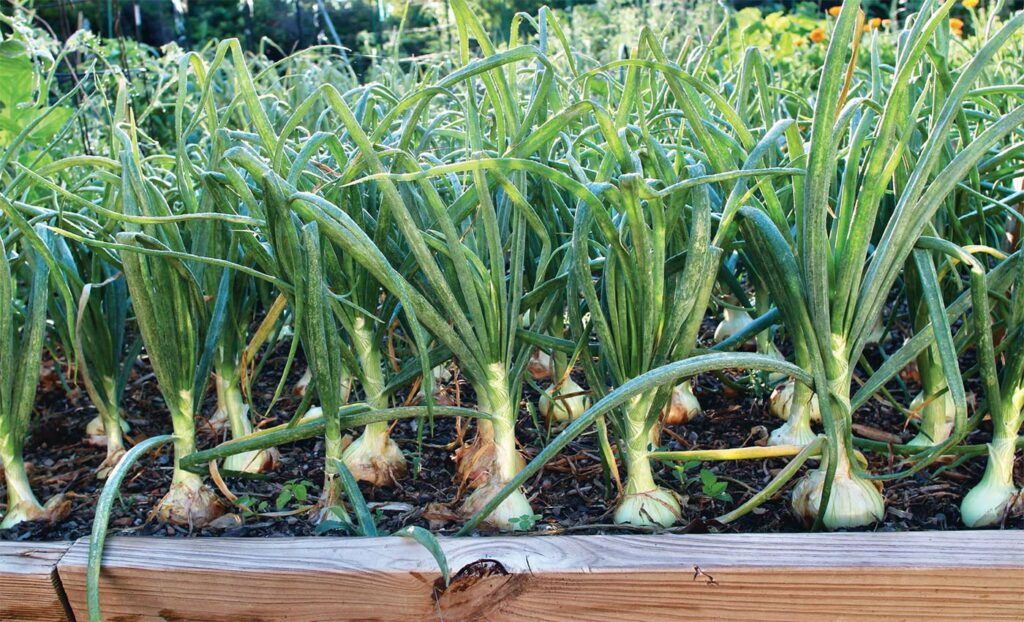
ONIONS, GARLIC, AND THEIR COUSINS LET YOU HARNESS BEAUTY AND BOUNTY
PHOTOGRAPHY CALLIE WORKS-LEARY
The complex, pungent, savory, sometimes sweet or umami-rich flavors created by onions and garlic find expression in many of our favorite fall dishes. But you might be surprised to learn that a great number of other alliums have a lot to offer, not only in the kitchen but in the home landscape as well.
Allium is a genus of hundreds of closely related members of the same plant family (Amaryllidaceae), which grow naturally all over the world. Many of them have diverse edible uses, and several species can be successfully grown in North Texas. As vegetables and herbs, alliums are not only an integral part of most global cuisines, they’re now also making a resurgence as popular ornamental landscape plants, with remarkable blooms that rival the most striking botanical blossoms.
Callie Works-Leary, Master Gardener and founder of the Dallas Garden School, is an ardent champion of alliums.
“Tomatoes tend to get all the attention when it comes to garden vegetables, but for passionate cooks, alliums are the true garden must-have,” says Works-Leary. “They play a supporting role in nearly every dish and cuisine, and the incomparable flavor you get from growing your own takes everything to the next level.”
As a group, you might say alliums have multiple layers, with a lot to offer both gardeners and gourmands!
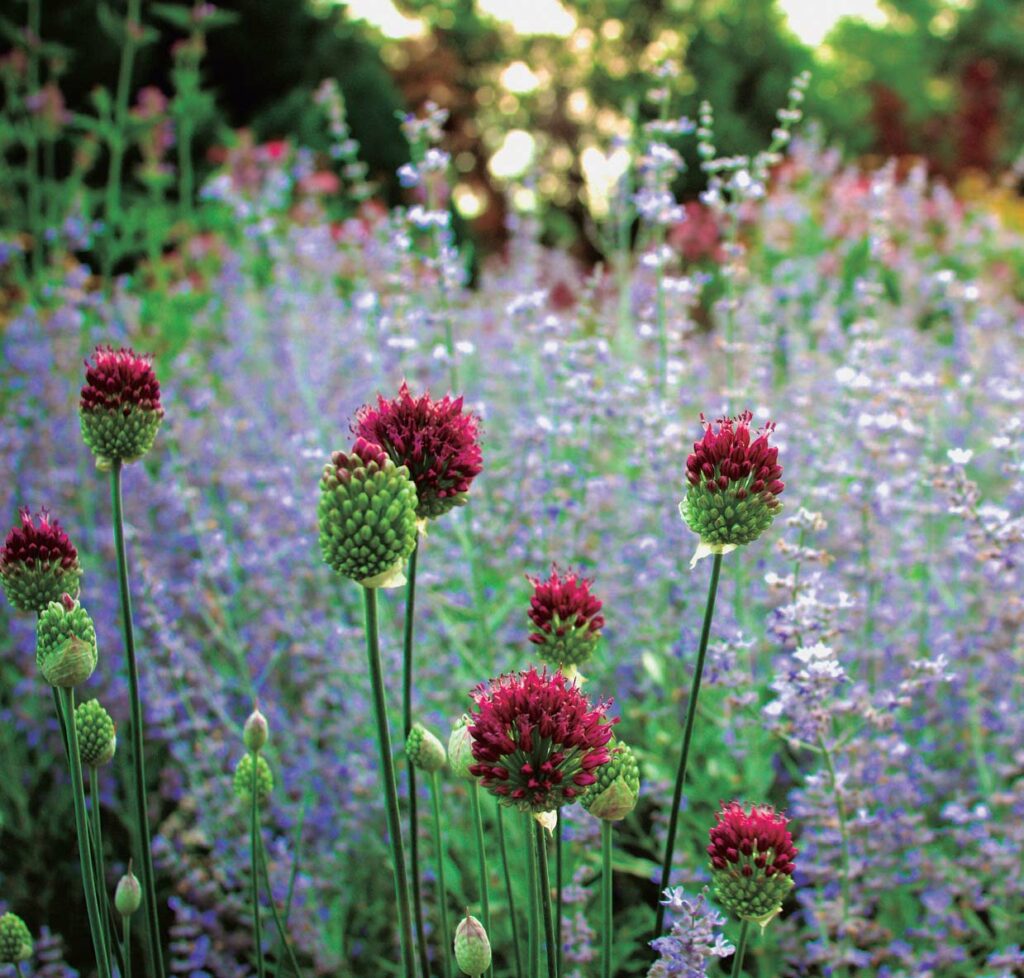
VEGETABLE ALLIUMS
A true vegetable is simply a plant of which we eat what is collectively called the “vegetative growth,” the leaves, stems, roots or immature flowers. Depending on the specific species of allium, you might eat any or perhaps all of those parts of the plant.
For budding gardeners, Works-Leary says vegetable alliums might just be the root of success.
“Chives are impossibly easy, especially since transplants are readily available, but garlic gets my vote for the perfect culinary allium for new gardeners. It requires very little care during the growing period and is adaptable to a wide range of soil types,” says Works-Leary.
“Plus, it can be grown in between other plants, which provides a pop of green foliage when the rest of the garden is still waking up in the spring,” she adds.
Gardeners can break vegetable alliums into two main groups: those that need to be replanted every year (annual alliums) and those that can be planted just once and continually harvested for seasons to come (perennial alliums).
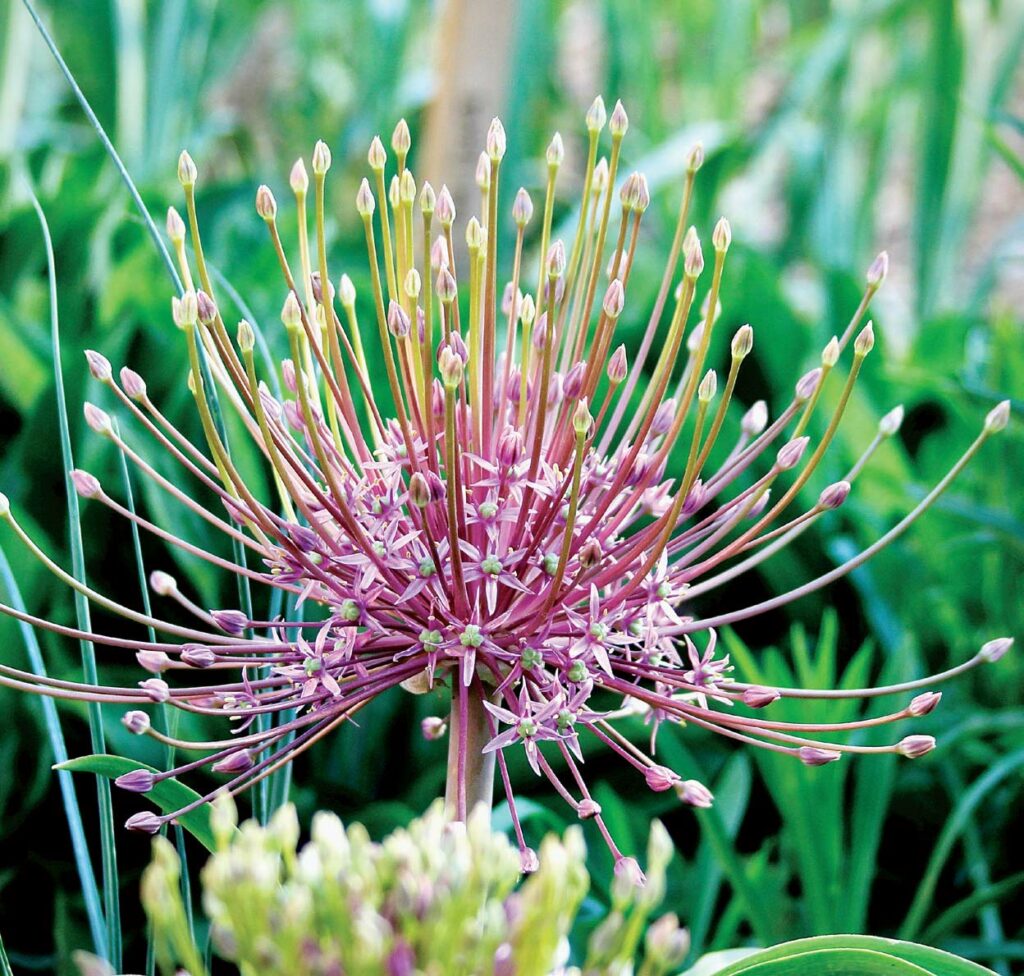
ANNUAL ALLIUMS
Garlic (A. sativum)
In North Texas, garlic bulbs, called “seed garlic,” can be sown mid-October. Plant individual cloves 1–3 inches deep and space them every 4–8 inches. Preferring cooler temperatures, these cloves grow over winter and can be harvested from late spring to early summer as temperatures creep back up.
The two main types of garlic, hardneck and softneck, each have their tradeoffs. And Works-Leary encourages gardeners to grow both.
“North Texas gardeners have long been told they can’t grow hardneck varieties, and that’s just not true. We can easily grow both softneck and hardneck garlics,” she explains.
Softneck garlics are typically more mild-flavored and have a longer shelf life. Hardneck garlics tend to have more complex flavors, and they also produce a young edible stem called a scape (or “neck”).
Works-Leary’s favorites are Music and Basque (hardnecks) and Kettle River Giant and Early Red Italian (softnecks).
Bulbing Onions (A. cepa)
Traditional globe-shaped bulbing onions are the most widely cultivated alliums on the planet and often a favorite for home gardeners. Our best adapted onions are short-day cultivars or those that begin expanding their large bulbs in the shorter daylight hours. The varieties below are some of the best for North Texas, and can be planted by seed in mid- to late October, slowly growing over winter.
- Yellow “Sweet” Onions: 1015, Texas Early Grano, Yellow Granex
- Red Onions: Southern Belle Red, Red Creole
- White Onions: (A. cepa) Early Texas White, White Bermuda
Alternatively, for those pressed for time or wary of seed-sowing, young onion seedlings (called “sets”) of the same cultivars can be bought and transplanted into the garden from late January to mid-February, (onion) ringing in the new year.
White Bunching Onions (A. fistulosum)
Also known as spring onions, Japanese bunching onions, and Welsh onions, these scallion-like onions can be planted by seed in October for a quick harvest in fall or planted in February and harvested before temperatures get in the nineties (or do both!). They can be harvested again and again by cutting the tops two inches above the soil line. And, if you never harvest the whole plant (root and all), they might even continue to produce next season.
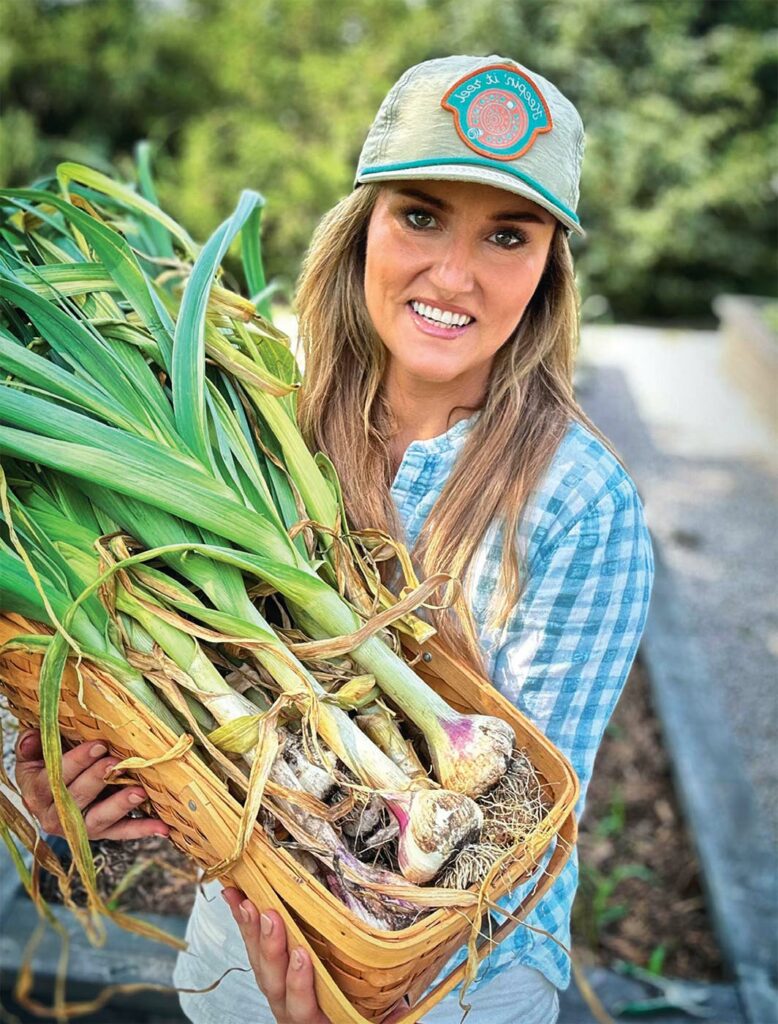
PERENNIAL ALLIUMS
Some alliums are true perennials in North Texas, coming back year after year following the initial planting. Because they can withstand our winter extremes, fall is a perfect time to plant.
Onion chives and garlic chives can be planted starting in September or whenever you start to see transplants in nurseries, according to Works-Leary.
Garlic Chives (A. tuberosum)
Often available either as seeds or as transplants, garlic chives are extremely easy to grow. The long flat leaves can be continuously snipped as needed for any recipe that calls for chives. Bonus: Their 2-inch white blooms are a favorite of both diners and pollinators! And once a stand of garlic chives is established, one nearly always has the pungent staple, as they spread vigorously to form colonies.
Onion Chives (A. schoenoprasum)
Similar to their garlicky cousin, onion chives are easily grown by seeds or transplants. Their round, hollow leaves have a milder, even slightly sweeter flavor. The pink to purple spring blooms are quite ornamental as well, but unlike garlic chives, onion chives tend to fizzle out in summer.
Still, Works-Leary favors them.
“I always have at least 3–4 onion chive plants on the patio just outside my kitchen at all times. I use them as a garnish for many different dishes, but I enjoy making an onion chive vinaigrette to dress roasted fall vegetables like eggplant, kabocha squash, Chioggia beets, or my spring-harvested sweet bulbing onions,” she says.
Elephant Garlic (A. ampeloprasum)
Commonly seen in grocery stores, the bulb of this plant (more closely related to leeks) is significantly larger than traditional garlic bulbs, but with a milder flavor profile. This allium can be planted by single cloves in the fall (either store-bought or by harvesting from existing plants). Mature plants can exceed 3 feet and explode with 4–5-inch white blooms from late spring through summer.
Tree/Walking Onions (Allium x proliferum)
Also called Egyptian Walking onions, the hybrid of the aforementioned bulbing (A. cepa) and bunching onions (A. fistulosum) is another perennial onion that remarkably doesn’t actually produce flowers. Instead, clusters of bulblets form at the top of the plant. These bulblets will actually sprout when atop the mother plant, sometimes weighing it down so much that the stems arch under the weight, leading to the hallmark phenomenon of rooting or “walking” a few inches each season.
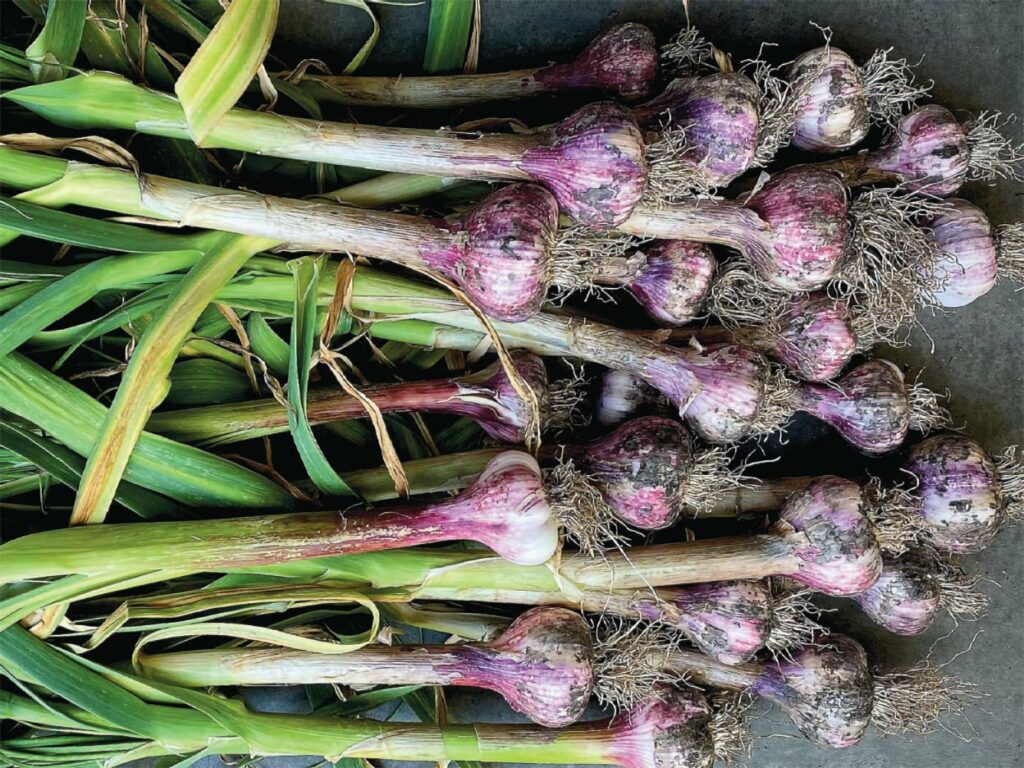
ORNAMENTAL ALLIUMS
Many of the aforementioned culinary alliums look surprisingly beautiful in the garden too. But one group of onion and garlic relatives flips the script, with breathtaking, exceptionally showy flowers long cultivated for their ornamental value alone. Some ornamental alliums are actually edible to boot!
Works-Leary has her personal garden favorites for fall. She plants them at the same time as her tulips and daffodils, in late November through late December.
She says she can’t get enough of Allium sphaerocephalon (Drumstick Allium). “It has delicate, spindly stalks that grow to about 2 feet tall, and in early summer, when most alliums have faded, it produces 1-inch, pinkish-purple, spherical flower heads that will stop you in your tracks!” she says.
Drumstick Allium (A. sphaerocephalon)
Native to Eurasia and North Africa, this allium has long been prized by gardeners for its small but showy purple egg-shaped flower heads that provide an incredible floral display. Meanwhile the leaves, stems, and bulbs are completely edible.
Gladiator Allium (A. giganteum)
As their name suggests, these plants are gigantic. The large, globe-shaped purple blooms on this onion relative can exceed 5 inches in width, rising on stems up to 3 feet tall. While these remarkably showy blooms are truly spectacular, they are less adapted than most of the other alliums in this list, so they might need to be replanted every few years.
Millenium Onions (A. Millenium)
Millennium is a hybrid ornamental onion that generally grows in 18–20 inch clumps which are topped by extremely showy purple umbels in late summer. The leaves, bulbs, and flowers are all edible, but the flavor is very strong, so a little goes a long way!
Tumbleweed Allium (A. schubertii)
“Another ornamental allium that will always be in my garden is Allium schubertii. It emerges in early spring, and the starburst-shaped, pale pink flower heads can get up to 12 inches in diameter,” says Works-Leary.
The outstanding pink to purple firework-like blooms of the tumbleweed Allium explode atop shorter 18-inch stems. But, although they provide dramatic effect in the garden, they might not be the best choice for eating. While the general consensus among foragers is that all alliums are technically edible (for mature humans), some can taste rather strong and unpleasant to some folks. The tumbleweed alliums are sometimes considered less than palatable.
Awesome Alliums
To dig deeper into the amazing world of alliums, Works- Leary is offering an in-depth virtual program this fall as part of her extensive Dallas Garden School curriculum. You’re sure to find it a-peeling!
Awesome Alliums: Onions, Garlic & Ornamentals Live on Zoom, September 29 at 12:00 pm CST. Visit school.thedallasgarden.com for more information.
Daniel Cunningham, Horticulturist with Texas A&M AgriLife's Water University program. His primary focus is a holistic approach to landscaping and food production systems. Cunningham specializes in Texas native plants and trees, vegetable gardening, edible landscaping, rainwater harvesting and is passionate about utilizing landscapes as habitat for benecial wildlife. For more gardening advice om Daniel, tune in to NBC DFW (Channel 5) on Sunday mornings or ask @TxPlantGuy on Facebook, Twitter or Instagram.
- Daniel Cunninghamhttps://www.edibledfw.com/author/dcunningham/
- Daniel Cunninghamhttps://www.edibledfw.com/author/dcunningham/
- Daniel Cunninghamhttps://www.edibledfw.com/author/dcunningham/
- Daniel Cunninghamhttps://www.edibledfw.com/author/dcunningham/







